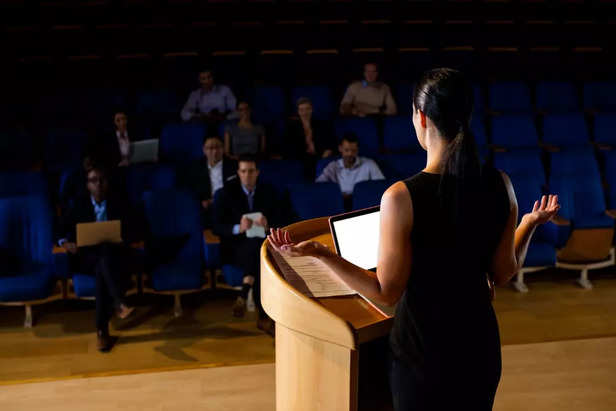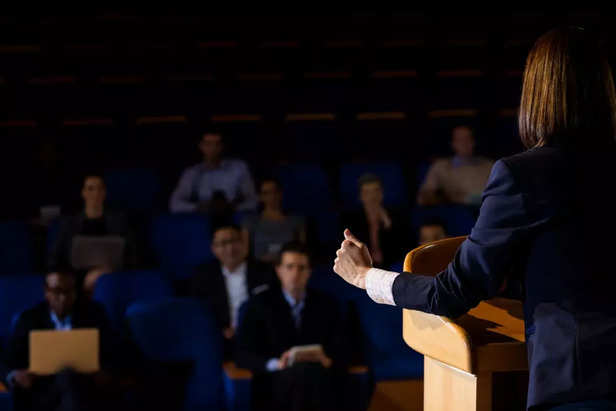From Shy to Confident: The Books That Transformed My Communication Skills
Nabila Mulla | Wed, 02 Apr 2025
Ever felt like your shyness is holding you back? Dive into this fun and engaging guide where I share my personal journey from being tongue-tied to a confident communicator, all thanks to some incredible books. Whether you're looking to charm at parties or speak up in meetings, these top communication skills books have got you covered. Let's embark on this transformative adventure together!

Photo:
I still remember the first time I had to speak in front of a group. My palms were sweaty, my voice trembled, and I could barely make eye contact. The fear of public speaking and my overall lack of communication skills held me back in both personal and professional settings. Determined to overcome this, I turned to literature for guidance. The journey through various books not only enhanced my communication abilities but also transformed my confidence. Let's dive into the books that turned my communication woes into wows!
1. "How to Win Friends and Influence People" by Dale Carnegie

Ah, the granddaddy of all communication books! Dale Carnegie's classic taught me that being genuinely interested in others is the secret sauce to making friends. Instead of worrying about what to say, I learned to listen, ask questions, and show appreciation. Suddenly, conversations felt less like interrogations and more like... well, conversations!
One golden nugget from this book is the power of remembering names. People love hearing their own names—it’s like music to their ears. So, I started making a conscious effort to remember and use names, and voilà! My interactions became warmer and more personal.
2. "Talk Like TED: The 9 Public-Speaking Secrets of the World's Top Minds" by Carmine Gallo

Public speaking used to be my personal nightmare. Enter Carmine Gallo, who dissected the best TED Talks to uncover what makes them so captivating. The biggest takeaway? Storytelling. People crave stories, not just facts. By weaving personal anecdotes into my talks, I found that my audience (even if it was just my cat) was more engaged and responsive.
Gallo also emphasizes the importance of passion. When you're genuinely excited about your topic, it’s contagious. I started choosing subjects I was passionate about, and guess what? My enthusiasm rubbed off on my listeners, making my presentations more lively and less like a lullaby.
3. "The Art of Public Speaking" by Stephen Lucas

This book became my go-to manual for all things public speaking. Stephen Lucas breaks down the process into bite-sized pieces, making it less daunting. One chapter that stood out was about the power of practice. I realized that even the best speakers don’t wing it—they rehearse. A lot.
Another gem was the section on audience analysis. Understanding who you're speaking to allows you to tailor your message effectively. So, before any presentation, I started researching my audience, which helped me connect with them on a deeper level.
4. "Crucial Conversations: Tools for Talking When Stakes Are High" by Kerry Patterson, Joseph Grenny, Ron McMillan, and Al Switzler

Ever had to discuss something super important but were terrified of how it might go? This book was a lifesaver. It taught me how to handle high-stakes conversations without turning them into shouting matches or awkward silences.
One strategy I adopted was creating a safe environment for dialogue. By ensuring that both parties felt respected and heard, discussions became more productive. I also learned the art of staying calm, even when the conversation got heated—a skill that's handy both in the boardroom and during family dinners.
5. "Confessions of a Public Speaker" by Scott Berkun

Scott Berkun's candid tales of his speaking adventures (and misadventures) made me realize that even seasoned speakers face challenges. His humorous approach reminded me that it's okay to make mistakes—they make for great stories later!
One of my favorite takeaways was the importance of authenticity. Trying to be someone you're not is exhausting and transparent. Embracing my quirks and being genuine made my speeches more relatable and less robotic.
6. "TED Talks: The Official TED Guide to Public Speaking" by Chris Anderson

Who better to learn from than the curator of TED himself? Chris Anderson provides a behind-the-scenes look at what makes TED Talks so compelling. His emphasis on focusing on a single idea helped me streamline my presentations, making them more impactful.
Anderson also highlights the importance of vulnerability. Sharing personal struggles and triumphs can create a powerful connection with the audience. I started opening up more in my talks, and the response was overwhelmingly positive.
7. "Speak With Confidence" by Mike Acker

Mike Acker's practical advice on overcoming fear and connecting authentically with audiences was a game-changer. One technique that stood out was the "circle of confidence" exercise, where you visualize a circle around you filled with positive energy before speaking. Sounds woo-woo, but it worked wonders for my nerves.
Acker also stresses the importance of preparation. Knowing your material inside and out boosts confidence. I started dedicating more time to prep, and it paid off in spades during my presentations.
8. "The Quick and Easy Way to Effective Speaking" by Dale Carnegie

Yes, another one by Carnegie! This gem focuses specifically on speaking effectively. One principle that resonated with me was the idea of "earning the right" to talk about a subject. By drawing from personal experiences and thorough research, I felt more credible and confident in my speeches.
Carnegie also emphasizes the power of enthusiasm. Speaking with energy and passion makes your message more compelling. I started injecting more enthusiasm into my delivery, and it made a noticeable difference.
9. "Resonate: Present Visual Stories that Transform Audiences" by Nancy Duarte

Nancy Duarte's focus on visual storytelling transformed the way I approached presentations. She advocates for using visuals that complement your narrative, rather than overwhelming slides filled with bullet points.
One technique I adopted was creating a "sparkline" for my presentations—a visual representation of the emotional highs and lows in my talk. This helped me craft more engaging and dynamic speeches that kept audiences hooked.
10. "Just Listen: Discover the Secret to Getting Through to Absolutely Anyone" by Mark Goulston

Communication isn't just about talking; it's about listening. Mark Goulston's book opened my eyes to the power of active listening. By truly tuning into others, I found that my relationships deepened, and misunderstandings became less frequent. One simple trick that worked wonders? The "three-second pause"—instead of jumping in with a response right away, I’d pause for three seconds to fully absorb what the other person was saying. It made my replies more thoughtful and meaningful.
Goulston also emphasizes the importance of mirroring emotions. When you show someone that you truly understand and acknowledge their feelings, they become more open to communication. I started practicing this in everyday conversations, and I was surprised at how much more connected I felt to people.
And there you have it! These books didn't just teach me how to talk better; they gave me the confidence to engage, connect, and express myself without the fear of stumbling over my words. Whether you're looking to ace a presentation, have smoother conversations, or just stop feeling awkward at social gatherings, these must-read books on communication skills have got you covered.
If I, the former master of avoiding eye contact, can transform my communication skills, then trust me—you can too! Grab one (or all) of these books, put the lessons into practice, and watch as your confidence soars. Who knows? You might just become the life of the party. Happy reading and happy talking!
Unlock insightful tips and inspiration on personal growth, productivity, and well-being. Stay motivated and updated with the latest at My Life XP.
1. "How to Win Friends and Influence People" by Dale Carnegie

Make Meaningful Connections!
Ah, the granddaddy of all communication books! Dale Carnegie's classic taught me that being genuinely interested in others is the secret sauce to making friends. Instead of worrying about what to say, I learned to listen, ask questions, and show appreciation. Suddenly, conversations felt less like interrogations and more like... well, conversations!
One golden nugget from this book is the power of remembering names. People love hearing their own names—it’s like music to their ears. So, I started making a conscious effort to remember and use names, and voilà! My interactions became warmer and more personal.
2. "Talk Like TED: The 9 Public-Speaking Secrets of the World's Top Minds" by Carmine Gallo

Speak Like A TED Pro!
Public speaking used to be my personal nightmare. Enter Carmine Gallo, who dissected the best TED Talks to uncover what makes them so captivating. The biggest takeaway? Storytelling. People crave stories, not just facts. By weaving personal anecdotes into my talks, I found that my audience (even if it was just my cat) was more engaged and responsive.
Gallo also emphasizes the importance of passion. When you're genuinely excited about your topic, it’s contagious. I started choosing subjects I was passionate about, and guess what? My enthusiasm rubbed off on my listeners, making my presentations more lively and less like a lullaby.
3. "The Art of Public Speaking" by Stephen Lucas

Turn Fear Into Confidence!
This book became my go-to manual for all things public speaking. Stephen Lucas breaks down the process into bite-sized pieces, making it less daunting. One chapter that stood out was about the power of practice. I realized that even the best speakers don’t wing it—they rehearse. A lot.
Another gem was the section on audience analysis. Understanding who you're speaking to allows you to tailor your message effectively. So, before any presentation, I started researching my audience, which helped me connect with them on a deeper level.
4. "Crucial Conversations: Tools for Talking When Stakes Are High" by Kerry Patterson, Joseph Grenny, Ron McMillan, and Al Switzler

Handle Tough Talks Like A Pro!
Ever had to discuss something super important but were terrified of how it might go? This book was a lifesaver. It taught me how to handle high-stakes conversations without turning them into shouting matches or awkward silences.
One strategy I adopted was creating a safe environment for dialogue. By ensuring that both parties felt respected and heard, discussions became more productive. I also learned the art of staying calm, even when the conversation got heated—a skill that's handy both in the boardroom and during family dinners.
5. "Confessions of a Public Speaker" by Scott Berkun

Laugh, Learn, And Speak Boldly!
Scott Berkun's candid tales of his speaking adventures (and misadventures) made me realize that even seasoned speakers face challenges. His humorous approach reminded me that it's okay to make mistakes—they make for great stories later!
One of my favorite takeaways was the importance of authenticity. Trying to be someone you're not is exhausting and transparent. Embracing my quirks and being genuine made my speeches more relatable and less robotic.
6. "TED Talks: The Official TED Guide to Public Speaking" by Chris Anderson

Secrets Of Great Talks!
Who better to learn from than the curator of TED himself? Chris Anderson provides a behind-the-scenes look at what makes TED Talks so compelling. His emphasis on focusing on a single idea helped me streamline my presentations, making them more impactful.
Anderson also highlights the importance of vulnerability. Sharing personal struggles and triumphs can create a powerful connection with the audience. I started opening up more in my talks, and the response was overwhelmingly positive.
7. "Speak With Confidence" by Mike Acker

Own The Room!
Mike Acker's practical advice on overcoming fear and connecting authentically with audiences was a game-changer. One technique that stood out was the "circle of confidence" exercise, where you visualize a circle around you filled with positive energy before speaking. Sounds woo-woo, but it worked wonders for my nerves.
Acker also stresses the importance of preparation. Knowing your material inside and out boosts confidence. I started dedicating more time to prep, and it paid off in spades during my presentations.
8. "The Quick and Easy Way to Effective Speaking" by Dale Carnegie

Speak Clearly And Persuasively!
Yes, another one by Carnegie! This gem focuses specifically on speaking effectively. One principle that resonated with me was the idea of "earning the right" to talk about a subject. By drawing from personal experiences and thorough research, I felt more credible and confident in my speeches.
Carnegie also emphasizes the power of enthusiasm. Speaking with energy and passion makes your message more compelling. I started injecting more enthusiasm into my delivery, and it made a noticeable difference.
9. "Resonate: Present Visual Stories that Transform Audiences" by Nancy Duarte

Storytelling For Impact!
Nancy Duarte's focus on visual storytelling transformed the way I approached presentations. She advocates for using visuals that complement your narrative, rather than overwhelming slides filled with bullet points.
One technique I adopted was creating a "sparkline" for my presentations—a visual representation of the emotional highs and lows in my talk. This helped me craft more engaging and dynamic speeches that kept audiences hooked.
10. "Just Listen: Discover the Secret to Getting Through to Absolutely Anyone" by Mark Goulston

Better Conversations Start Here!
Communication isn't just about talking; it's about listening. Mark Goulston's book opened my eyes to the power of active listening. By truly tuning into others, I found that my relationships deepened, and misunderstandings became less frequent. One simple trick that worked wonders? The "three-second pause"—instead of jumping in with a response right away, I’d pause for three seconds to fully absorb what the other person was saying. It made my replies more thoughtful and meaningful.
Goulston also emphasizes the importance of mirroring emotions. When you show someone that you truly understand and acknowledge their feelings, they become more open to communication. I started practicing this in everyday conversations, and I was surprised at how much more connected I felt to people.
And there you have it! These books didn't just teach me how to talk better; they gave me the confidence to engage, connect, and express myself without the fear of stumbling over my words. Whether you're looking to ace a presentation, have smoother conversations, or just stop feeling awkward at social gatherings, these must-read books on communication skills have got you covered.
If I, the former master of avoiding eye contact, can transform my communication skills, then trust me—you can too! Grab one (or all) of these books, put the lessons into practice, and watch as your confidence soars. Who knows? You might just become the life of the party. Happy reading and happy talking!
Unlock insightful tips and inspiration on personal growth, productivity, and well-being. Stay motivated and updated with the latest at My Life XP.
Frequently Asked Questions (FAQs)
- Which books to read to improve communication skills?
Some great books are "How to Win Friends and Influence People" by Dale Carnegie, "Crucial Conversations" by Patterson et al., and "Never Split the Difference" by Chris Voss. - What are the 7 C's of communication skills?
The 7 C’s are Clarity, Conciseness, Consideration, Correctness, Concreteness, Courtesy, and Completeness—all essential for effective communication. - What are the 5 communication skills?
Listening actively, Speaking clearly, Non-verbal communication (body language), Emotional intelligence, Confidence and assertiveness are 5 essential communication skills. - What is the best book about communication?
"How to Win Friends and Influence People" by Dale Carnegie is often considered the best because it teaches practical and timeless communication techniques.










